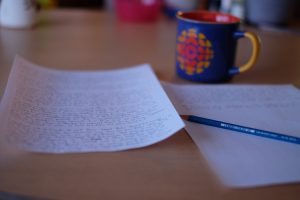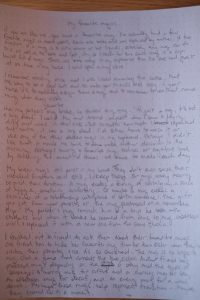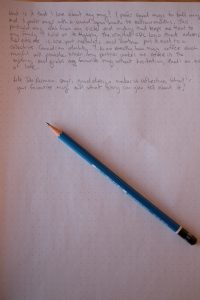
A picture I took of my writing while channeling my best inner millennial influencer
As an older millennial, computers were part of my school experience, but mostly we did our work by hand. I remember having a very prominent writer’s bump on my right hand that I was self conscious about. Over time, without me even noticing, my writer’s bump eventually disappeared ― a signal that indicated a shift from primarily manual writing to typing. I found the exercise of manually writing 500 words physically straining. Where my writer’s bump used to be was a purple, fleshy indent that became very tender. I can’t remember the last time I manually wrote 500 words in one sitting.
Compared to my typing, this was by far a more time consuming activity. When I made mistakes in my writing I either tried to correct the mistake, by writing directly on top of it (e.g. changing a lowercase ‘t’ to an uppercase ‘T’), or I crossed out the word with a line and continued writing. In the case of a missing word, I wrote the word overtop with a little arrow indicating where the word should be inserted. I used a pencil to complete this task and since I didn’t use an eraser, I believe I would have edited my work the same way with a pen.
It’s hard to say which form of writing, manual or typing, I prefer and I am reminded of something host Brad Harris said in an episode of The history of the modern world, “the value of a printed book is its content, but the value of a handwritten book was mostly the object itself” (Harris, 2018, 1:58). There is a charm to writing by hand and there is something to be said for the aesthetic appeal of manual writing. Doing this exercise has made me nostalgic for my late grandmother’s penmanship, or the notes my mum used to write me in my packed lunch. I enjoy manual writing when I’m doing something stylistic (e.g. crayligraphy or brush lettering) or personal, like writing a letter to a friend. I also write manually when I know it will take less time to write something down than to open a computer (e.g. grocery list). On the other hand, I prefer typing for assignments, lesson planning, daily correspondence, and anything that requires professional or formal writing. In my opinion the benefits to typing are speed, uniformity, ease of editing, and ease of sharing documents.


References
Harris, B. (Host). (2018, February 5th). The printed book: Opening the floodgates of knowledge [Audio podcast episode]. In How it began: A history of the modern world. https://howitbegan.com/episodes/the-printed-book/.
